
Of the 3bn global television audience, 43m of the viewers of the Sochi Winter Olympics Opening Ceremony were Russian. In the US alone, the ceremony’s audience was 31.7m people. Together, the main US networks will give the Sochi Olympics the greatest amount of US coverage in Winter Games history.
However you measure them, the ceremony and the competitions that were to follow were big in broadcasting.
In spite of the reappearance of #NBCFail Twitter hashtag, which revels in the network’s mistakes and misfortunes, Olympic broadcasts have become a technical and logistical tour de force for the broadcast industry. Together NBC, NBC SN, CNBC, MSN BC, the USA Network and NBC Olympics.com will deliver more than 1,500 hours of Olympic coverage. That’s just NBC…
Olympic networking
Something that will frustrate the Olympic games’ TV Twitter critics is the broadcasters’ choice of technologies.
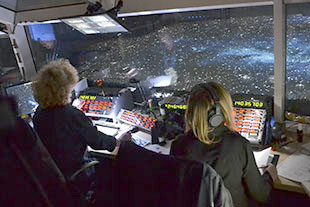
The excitement that accompanies the elation of a win or the disappointment of a failure in the Winter Games events has no place in their broadcast facilities. Here, certainty is essential. Key to the technical infrastructure is the Riedel MediorNet fibre-based network, that carries HD video and audio, data and Riedel Artist intercom signals throughout the event’s facilities. The system provides a double-redundant backbone within the 40,000-capacity Fisht Stadium and other venues that feed back to the International Broadcast Centre (IBC). Eighteen Riedel Artist digital matrix intercom mainframes ensure reliable communications at the competition sites.
‘The solutions we’re providing in Sochi build on successful deployment at the London Games,’ says Marc Schneider, Riedel Communications Director of International Projects.
At the Fisht Stadium – where the games’ opening and closing ceremonies are being staged, and which will subsequently be used for the Football World Cup 2018 – the MediorNet infrastructure comprises multiple interfaces and repeater sites to support wired and wireless Ethernet distribution. This provides both a local Wi-Fi network and facilitates programming, coordination and management of programme elements during the ceremonies. Supplied and coordinated by Riedel, the installation supports 90 discreet radio channels for more than 1,300 radio systems and 1,000 headsets. The deployment also makes audio available to artists performing at the games’ opening and closing events.
In addition, more than 70 EVS XT media production servers are in use for NBC’s coverage of the event – 20 will be used at the NBC Olympics central broadcast production facility at the IBC, and another 30 at NBC production centres in Stamford and New York. The remaining servers are located at individual venues.
 ‘Over the years and across numerous locations, EVS has been an instrumental part of the onsite broadcast architecture for the Olympic Games,’ says EVS Senior VP of the Americas, Frederic Garroy. ‘Our Sochi deployment will bring even greater system flexibility and connection between venues, and extremely tight integration with Avid Interplay. While the workflow is clearly defined, EVS provides the tools to enable editors and engineers to push the bounds of technology.’
‘Over the years and across numerous locations, EVS has been an instrumental part of the onsite broadcast architecture for the Olympic Games,’ says EVS Senior VP of the Americas, Frederic Garroy. ‘Our Sochi deployment will bring even greater system flexibility and connection between venues, and extremely tight integration with Avid Interplay. While the workflow is clearly defined, EVS provides the tools to enable editors and engineers to push the bounds of technology.’
Responsible for providing the audio and video feeds for NBC Universal (including the NBC broadcast network, Spanish language network Telemundo, as well as many of the company’s cable networks) NBC Olympics has installed the Cedar DNS 8 Live units at the IBC.
US distributor Independent Audio’s Dennis Gaines oversaw the installation and testing of the broadcast systems. The first time the NBC engineers put the DNS 8 Live to use in a real situation, he reported: ‘They have it inserted on a bus and in continuous learn mode. It removed the noise, reduced echo in the room and allowed them to get a further 3dB-4dB before feedback – they were fully convinced.’
‘Since releasing the DNS1000 in 2000, Cedar has a proud history of use at the Winter Olympics and Summer Olympics, as well as the FIFA World Cup and the Super Bowl in the US,’ says Cedar Sales Director, Clive Osborn. ‘We have removed crowd noise, equipment noise, studio noise and even vuvuzelas to help ensure the highest quality broadcasts from all of these events. NBC Olympics first purchased DNS1000s for the 2004 Summer Olympics in Athens, and we are delighted that it has added these DNS 8 Lives to its arsenal for 2014.’
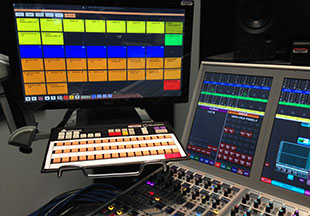
NBC also added three Merging Technologies Ovation Multi-Media Players to the four it has been using at the NBCSN Sports Center in Stamford, Connecticut. The equipment list for Sochi for NBC Olympics includes three Ovations and three Horus mic preamplifier I/O units. Each Horus processor has three AD8D Input modules and three DA8 Output modules, all operating at 192kHz. The full suite of digital I/O and Ravenna remote control of the routing and configuration of Horus allows NBC easy set-up and high-quality output.
The Ovation/Horus set-up is connected to Calrec Artemis consoles via AES/EBU, with the dedicated keyboard controller located next to the console surface. The Primetime show’s theme music is cued on Ovation with a live voiceover channel and ‘bumpers’ in and out of the commercial breaks. Any stings or highlight music cues are also pre-configured in Ovation and fired from the keypad when needed. This controller is one of many different user interfaces for Ovation – touchscreen, web browsers or conventional keyboard and mouse can also be deployed as required.
Concert sound and installation specialist Avallon (Аваллон – Merging’s reseller for Russia) handled the audio in the main Fisht Arena, where Horus units are used to handle additional input signals and routing between the different systems. Horus is connected to a Stagetec Nexus audio network/router via Madi with the audio controlled by the Stagetec Auratus-24 located high in the stadium to give the operators an overview of the arena. This was the first Horus installation for Avallon’s engineers and went well: ‘We have now specified Horus for several football stadiums for the 2018 World Cup which is taking place in our country,’ Avallon President, Sergey Vashchenko reports.
As part of the crew for the International Broadcast Centre set up, Dennis Gaines trained freelance operators on the programming and operation of Ovation, as well as checking that the installation was fully operational. One early problem that was encountered was the inability of some other playout devices to accept a variety of audio file formats. Ovation can handle any incoming file format and it can also convert those files to alternatives with different sampling rates as needed.
‘It was a blast being in Sochi even though I had to leave before the games opened because there was nothing left to do,’ he says. ‘The systems were all up and running, and the guys were fully up to speed, so now I can watch the end result on the TV at home.’
‘I have seen the future of broadcast playout and its name is Ovation. Fortunately, it is available now,’ adds freelance A1, Rick Smith – one of the IBC trainees who had not encountered Ovation before.
Mixing in the clusters…
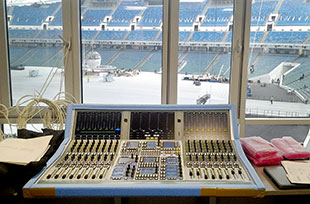 At the Fisht Stadium, the Merging systems are tied to two Salzbrenner Stagetec Auratus series mixing consoles, each equipped with six Nexus Base Devices supporting the audio network and interfacing for TV sound production, with a further Auratus and Nexus Base Device for sound reinforcement.
At the Fisht Stadium, the Merging systems are tied to two Salzbrenner Stagetec Auratus series mixing consoles, each equipped with six Nexus Base Devices supporting the audio network and interfacing for TV sound production, with a further Auratus and Nexus Base Device for sound reinforcement.
The Horus processors route signals from microphones around the field to the main audio system over optical links. The input and output modules of the Horus processors are used for additional audio sources, including Tascam CD and DVD players, JoeCo digital audio recorders, Telefunken microphones and Samson wireless mic systems. This routing allows flexibility for different events and competitions.
While the sound reinforcement for the Opening and Closing Ceremonies relies on equipment from rental companies, the installed system comprises 200 One systems CIM212 loudspeakers powered by 62 Dynacord H5000 amplifiers. Speakers and amplifiers will be installed after the Olympic Games.
The Fisht Stadium is part of Sochi’s Coastal Cluster of Olympic venues. These also include the Iceberg Skating Palace, where two Stagetec Auratus series consoles and a Nexus network are used for stadium sound reinforcement and TV audio from the stadium. The House of Switzerland houses two SRG SSR sound production areas in the Swiss House and the Swiss NBC, which are interconnected via a Nexus network. Also within the Coastal Cluster, the Swiss SRG SSR National Broadcast Centre is used by NBC to supply all Swiss programmes, and serves as the main control centre and uses Nexus Star and Nexus for its audio, with two Stagetec Crescendo series mixing consoles and associated Nexus networks in the SRG SSR sound control rooms at the NBC.
The Mountain Cluster, meanwhile, houses the Biathlon and Ski Complexes, a sliding track, an Alpine Ski Centre, a Ski Jump Complex, as well as a Snowboard Park and Freestyle Centre.
For the downhill races, three large OB vehicles from Switzerland are available to produce cleanfeeds for the classic alpine skiing disciplines. The vehicles have sound control rooms equipped with Stagetec Aurus consoles and extensive Nexus audio networks. Nexus networks on the slopes transmit the microphone and talkback signals to the production control rooms, while two Crescendo consoles and Nexus networks are placed in additional sound production areas for the snowboarding and freestyle skiing for Swiss SRF. The Laura Biathlon Center is equipped with a Delec commentary system – comprising oratis R4000 router with oratis MF4 matrix frames, numerous oratis Com3 commentary terminals and additional oratis Desk16 intercom subscriber units – as well as two Crescendo consoles and Nexus networks in the stadium and Media Centre.
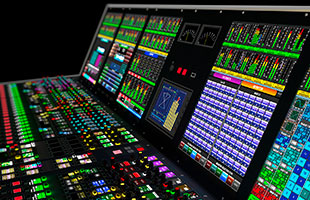 ‘As in 2012, our technology will be supporting the sound reinforcement and especially the TV broadcasting’, says Salzbrenner Stagetec Mediagroup MD, Stephan Salzbrenner. ‘The demand for high-quality mixing equipment and reliable audio networks is so high that we have sent a number of additional components to Sochi to extend the existing set-up temporarily.’
‘As in 2012, our technology will be supporting the sound reinforcement and especially the TV broadcasting’, says Salzbrenner Stagetec Mediagroup MD, Stephan Salzbrenner. ‘The demand for high-quality mixing equipment and reliable audio networks is so high that we have sent a number of additional components to Sochi to extend the existing set-up temporarily.’
Calrec also has an extensive role in the Winter Olympics, with a variety of mixing desks in use with a number of broadcasters. While NBC Olympics has five Calrec desks – two 72-frame and two 24-frame Artemis digital consoles in use at the IBC, and a 40-frame Artemis at the Sanki Sliding centre for the luge, skeleton and bobsled events – NTV Plus has four 32-frame and a 40-frame Artemis console, all networked together around a centre core to produce and play-out content 24/7.
‘After the success of the Summer Games in 2012, we are delighted to continue working with NBC Olympics and thank them for choosing our desks,’ says Henry Goodman, Calrec Head of Sales & Marketing.
‘The Artemis console’s reliability and consistency will help us to achieve outstanding audio quality across our NBC Olympic venues,’ says NBC Olympics Director of Sound Design, Karl Malone. ‘The fact that Calrec consoles are now the industry standard helps the audio mixers engage immediately with the artistic elements of the production, which previously might have taken more of their time.’
Additionally, Calrec has supplied stageboxes in digital, analogue and Madi formats to meet I/O requirements.
Calrec also has a strong presence in the OB operations in Sochi, with Telegenic’s Apollo-equipped T25 truck handling the host feed for both ceremonies at Fisht Stadium, and a further Apollo console in the T19 backup truck. The Visions HD2 truck will use its Sigma console for the host feed for the ceremonies at the Fisht Stadium and a further Sigma in its HD1 at the Bolshoy Ice Palace for ice hockey. Visions’ HD4, meanwhile, will set up its Alpha console at the Rosa Khutor Extreme Park for snowboarding, moguls and ski cross.
Canadian broadcaster CTV will be carrying news of its team’s successes using its Alpha-equipped OB2 at the Iceberg Skating Palace for the host feed of the figure skating and a further truck at the same venue for the host feed from the short track speed skating. Its OB7 (with a Zeta console) will cover the ski jumping at the Russki Gorki Ski Jumping centre, and its OB9 (with an Alpha) will be at the Rosa Khutor Alpine Centre for downhill skiing.
Press central
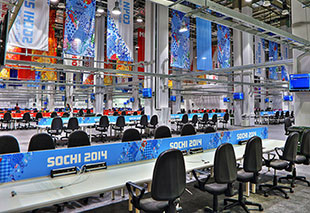
During the course of the games, the Main Media Centre catered for more than 2,000 members of the international press assigned to cover the event, and more than 6,000 television and radio broadcasters from around the world.
Moscow-based A/V company Proton Center designed the A/V system and supervised installation works, with its partner company, Sochi-based Tomlux+, handling the sound and video installation on site. A central element to its audio operation were the six Allen & Heath rackmount Qu-16 digital mixers supplied by Allen & Heath’s Russian distributor, MixArt.
The Qu-16 mixers were selected for their ability to provide the wide functionality and flexibility needed to complete various tasks, as well as to meet the diverse requirements of the vast number of broadcasting companies: ‘Visiting from more than 70 countries, press were arriving with many different types of A/V equipment, and Qu-16 worked seamlessly with all of it,’ says Alexander Soloviev from Proton Center.
Other sound equipment used in the centre included 30 Audio-Technica 3000 Series Wireless Systems and Denon Professional CD/media players.
Winter water
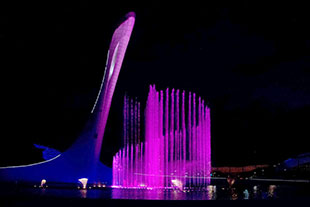 Accompanying the games and its intensive broadcasting operations, the Waters of Olympic Park provide a centrepiece to Medals Plaza. The fountain and sculpture installation by Southern Californian company WET puts on a water, fog and light show accompanied by music from an EAW QX Series sound system.
Accompanying the games and its intensive broadcasting operations, the Waters of Olympic Park provide a centrepiece to Medals Plaza. The fountain and sculpture installation by Southern Californian company WET puts on a water, fog and light show accompanied by music from an EAW QX Series sound system.
Surrounding the fountain’s 247-ft diameter, 700,000-gallon tank, is a white metal sculpture structure inspired by Russian composer Igor Stravinsky’s 1910 ballet The Firebird. The sculpture envelops the pool with its wings and holds the burning Olympic Cauldron. Inside its ‘neck’, an EAW QX Series and SB subwoofer system play out classic works from composers such as Tchaikovsky and Shostakovich.
‘The bird neck structure left very little space for a sound system,’ says WET Sound Design Audio Engineer, Jim Scheffler. ‘I had to have exceptional coverage and output, and the QX boxes were exactly what I needed.’
The audio system was not to be visible, and with a structural support 1m in diameter running up the centre, as well as the gas supply for the Olympic Cauldron’s flame, Scheffler had to choose components wisely. He achieved 270° coverage around the fountain with just eight QX series enclosures: four QX544i-WP as a centre cluster and another four QX564i-WP along the left and right sides, all powered by 12 Powersoft K10 DSP+AESOP two-channel power amplifiers. Additionally, he placed six SB2001 subwoofers at the base of the structure.
‘The EAW Resolution software made it easy to map out the performance I needed,’ Scheffler explains. Even though the nearest spectators are no less than 200 feet from the structure, he achieved more than 100dB of output at the closest range, and 85dB all the way to the extremes of the Olympic Park.
‘Our intention was for an extremely smooth, full-fidelity reproduction of music,’ he says. ‘Classical music is to be heard, not hyped, as close to linear as possible. This system has it all, from great sound to high output.’
It may not be what the #NBCFail hashtag team cheers for, but great sound and high output are what Olympic Games broadcasting is all about.
See also:
The Sound of Sport: What is Real?
More: www.calrec.com
More: www.cedaraudio.com
More: http://eaw.com
More: www.evs.com
More: www.joeco.co.uk
More: www.merging.com
More: www.onesystems.com
More: www.powersoft-audio.com
More: www.riedel.net
More: www.stagetec.com